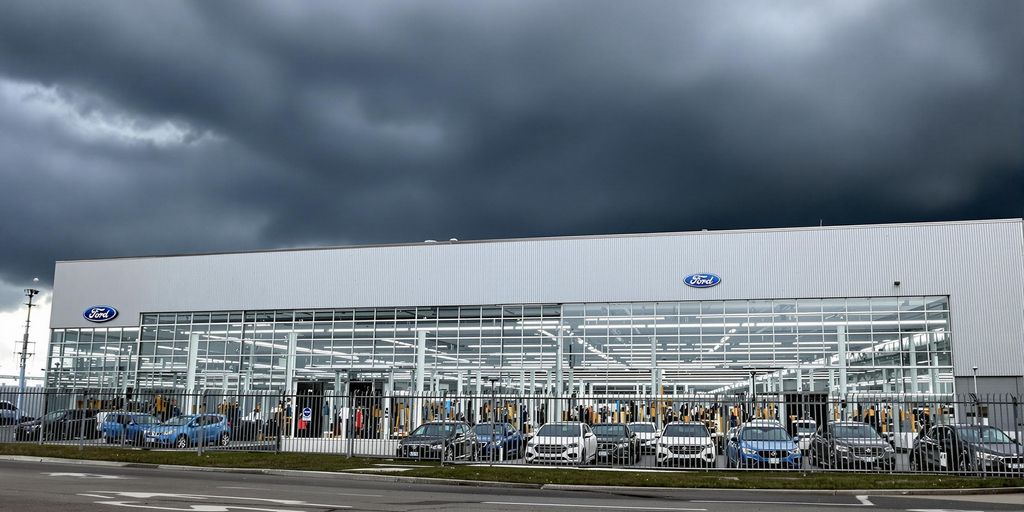Ford is sounding the alarm about the financial impact of tariffs, warning that these could cost the company $1.5 billion. This comes on the heels of a significant profit drop in the first quarter, which saw a staggering 65% decline compared to the previous year. As the automotive giant grapples with these challenges, it raises questions about its future profitability and competitive stance in the market.
Key Takeaways
- Ford expects tariffs to cost $1.5 billion, significantly impacting profitability.
- The company’s profit fell 65% in Q1, raising concerns among investors.
- Ford’s tariff costs are lower than those projected by General Motors due to a higher mix of U.S.-made vehicles.
- The automaker is implementing strategies like using bonded carriers to reduce tariff expenses.
- Market reactions indicate a cautious outlook for Ford as it navigates these financial hurdles.
Ford Warns of Tariff Toll Impact on Profitability
Projected Financial Losses
Ford is bracing for a significant financial hit due to tariffs. The company anticipates that tariffs could cost them around $1.5 billion. This projection has raised concerns among investors and analysts alike. It’s a big number, and it’s definitely something Ford is trying to get ahead of. The impact is expected to affect their bottom line, potentially hindering future investments and growth opportunities. Ford is actively assessing the situation to understand the full scope of the financial implications.
Comparison with Competitors
Interestingly, Ford’s projected tariff impact is lower than that of some competitors, like General Motors, which estimates losses between $4 billion and $5 billion. This difference is attributed to Ford’s higher percentage of vehicles manufactured in the United States. However, even with a comparatively lower impact, the $1.5 billion figure is still substantial and requires strategic action. It’s a reminder that everyone is getting hit, just in different ways. It’s interesting to see how different manufacturing strategies can affect a company’s vulnerability to tariffs.
Long-Term Financial Strategies
To mitigate these financial challenges, Ford is exploring several long-term financial strategies. These include:
- Adjusting pricing strategies to offset tariff costs.
- Optimizing the supply chain to reduce reliance on tariff-affected materials.
- Implementing cost-cutting measures across various operations.
Ford is actively working to minimize the impact of tariffs on its profitability. The company is focused on finding efficiencies and making strategic decisions to navigate these challenging times. They’re looking at everything from supply chains to manufacturing processes to see where they can save money and reduce their exposure to tariffs. It’s a tough situation, but they seem determined to weather the storm. They are also looking into Ford recalls to ensure customer satisfaction.
Ford is also considering using bonded carriers to transport vehicles and parts to Canada from Mexico, avoiding tariffs while passing through the U.S. It’s a complex situation, but Ford is trying to be proactive and find solutions that will protect their bottom line.
Analysis of Q1 Profit Decline
Factors Contributing to Profit Drop
Ford’s Q1 profit decline can be attributed to a mix of factors. Production hiccups, especially with the launch of new models, played a role. Higher commodity prices also squeezed margins, and increased warranty costs didn’t help either. It’s a tough combination to deal with, and it all hit Ford at once.
- Increased raw material costs (steel, aluminum)
- Launch-related production inefficiencies
- Higher warranty claims
Impact of Tariffs on Earnings
Tariffs are starting to bite, and Ford is feeling the pinch. The increased cost of imported components directly impacts their bottom line. It’s not just about the direct cost of the tariffs themselves, but also the ripple effect they have on the entire supply chain. It forces Ford to rethink where they source parts and how they manage their inventory.
Market Reactions and Investor Sentiment
Investors are understandably concerned about Ford’s recent performance. The Q1 profit decline, coupled with the tariff warnings, has led to some uncertainty. The stock price has reflected this, with some analysts downgrading their outlook for the company. It’s a wait-and-see approach for many, as they want to see how Ford navigates these challenges in the coming quarters.
Investor sentiment is a fickle thing. Right now, there’s a lot of worry about the automotive industry in general, and Ford’s specific challenges are adding to that. People are watching closely to see if Ford can turn things around and deliver on its promises.
Ford’s Strategies to Mitigate Tariff Costs
Ford is actively working to lessen the financial hit from tariffs. It’s not just sitting back and taking it; the company is trying different things to protect its bottom line. Here’s a look at some of the ways Ford is fighting back against these costs.
Use of Bonded Carriers
One strategy Ford uses involves bonded carriers. Basically, instead of goods from Mexico passing through the U.S. on their way to Canada and getting taxed, Ford uses bonded carriers. These carriers allow the goods to move through the U.S. without being subject to tariffs. This is especially useful for transporting vehicles and parts.
Adjustments in Supply Chain
Ford is also tweaking its supply chain to cut down on tariff expenses. This might mean finding new suppliers in countries with lower tariffs or moving production to places where costs are more manageable. It’s all about finding the most efficient and cost-effective way to get things done. Ford has been relocating vehicle transport from Mexico to Canada.
Cost-Cutting Measures
Beyond supply chain adjustments, Ford is looking at other ways to save money across the board. This could involve anything from streamlining operations to reducing overhead costs. The goal is to become leaner and more efficient so that the company can better absorb the impact of tariffs. These measures are designed to improve overall financial health.
Ford is trying to lower its tariff costs by about 35 percent. This involves strategies like using bonded carriers to move vehicles and parts from Mexico to Canada, avoiding taxes while passing through the U.S.
Industry-Wide Effects of Tariffs
Comparative Analysis with General Motors
Ford isn’t the only one feeling the pinch. General Motors estimates higher tariff costs, around $4 billion to $5 billion. Ford believes its U.S.-built vehicle mix helps keep its tariff impact lower. It’s a game of managing supply chains and production locations to minimize the tariff hit. Both companies are trying to find ways to lessen the impact, but it’s clear tariffs are a major concern for both.
Impact on Other Automakers
It’s not just Ford and GM. Tariffs are creating headaches for pretty much everyone in the auto industry. European and Asian automakers are also affected, especially those who import vehicles or parts into the U.S. Some smaller companies might struggle more to absorb these costs, potentially leading to price increases or even production cuts. The whole industry is having to rethink its strategies.
- Increased costs for imported parts.
- Potential price hikes for consumers.
- Disruptions to established supply chains.
Broader Economic Implications
Tariffs don’t just affect car companies; they ripple through the entire economy. Think about the suppliers, the dealerships, and all the related businesses. If car prices go up, people might delay buying new vehicles, which can slow down economic growth. It’s a complex situation with lots of interconnected parts. Some analysts worry about a potential trade war and its long-term effects.
Tariffs can lead to inflation, reduced consumer spending, and decreased international trade. The automotive industry, with its global supply chains, is particularly vulnerable to these effects. It’s a balancing act between protecting domestic industries and maintaining a healthy, open global market.
Future Outlook for Ford Amid Tariff Challenges
Predictions for Upcoming Quarters
Ford is facing a tough road ahead, no doubt. With the initial $1.5 billion hit from tariffs, it’s reasonable to expect continued pressure on their financials in the coming quarters. A lot hinges on how effectively they can implement their mitigation strategies. If they can’t get a handle on costs, we might see further profit declines. It’s not all doom and gloom, though. The automotive market is always changing, and Ford has a history of adapting. Whether they can do it fast enough this time is the big question.
Potential Changes in Production
To combat the tariff impact, Ford might need to rethink where and how they produce vehicles. Shifting production to areas less affected by tariffs could be one option. We might see more investment in U.S.-based manufacturing, especially if there are government incentives involved. Another possibility is increasing the use of imported parts from countries with more favorable trade agreements. It’s a complex puzzle, and Ford will need to weigh the costs and benefits of each move carefully.
Market Positioning Strategies
Ford’s got to figure out how to stay competitive while dealing with these extra costs. One approach could be to focus on higher-margin vehicles, like trucks and SUVs, where they have a stronger market position. They might also try to pass some of the tariff costs onto consumers through slightly higher prices, but that risks losing sales. Another strategy is to double down on innovation, developing new technologies and features that justify a premium price. It’s a balancing act, and Ford will need to be smart about how they position themselves in the market.
Ford’s future success depends on its ability to navigate the complex web of tariffs and trade regulations. This requires a proactive approach, including supply chain adjustments, cost management, and strategic market positioning. The company’s long-term viability hinges on its capacity to adapt to these challenges and maintain profitability in an increasingly competitive global market.
Responses from Ford Executives
Statements from the CEO
Ford’s CEO addressed the financial challenges head-on, acknowledging the impact of tariffs on the company’s bottom line. The CEO emphasized Ford’s commitment to navigating these difficulties through strategic adjustments and a focus on long-term growth. He highlighted the company’s ongoing efforts to streamline operations and invest in future technologies, such as electric vehicles, to ensure Ford’s competitiveness in a changing market. He also mentioned ongoing talks with suppliers to mitigate costs.
Insights from Financial Analysts
Financial analysts have offered varied perspectives on Ford’s situation. Some analysts express concern over the immediate impact of tariffs, while others point to Ford’s underlying strengths and potential for recovery. One analyst noted that Ford’s cost-cutting measures might not be enough to offset the tariff impact completely. Another analyst suggested that Ford’s investments in electric vehicles could provide a competitive edge in the long run. It’s a mixed bag of opinions, really.
Reactions from Industry Experts
Industry experts weighed in on Ford’s financial news, providing context and broader implications. Some experts noted that Ford’s challenges are not unique, as other automakers face similar pressures from tariffs and changing consumer preferences. Others suggested that Ford’s response to these challenges will be a key indicator of its long-term viability. One expert pointed out that Ford’s brand reputation could play a significant role in weathering the storm. It seems like everyone has an opinion, but the general consensus is that Ford has a tough road ahead.
It’s important to remember that the automotive industry is cyclical. Ford has faced challenges before and overcome them. The company’s ability to adapt and innovate will be crucial in navigating the current environment.
Consumer Reactions to Ford’s Financial News
Impact on Brand Loyalty
Ford’s recent financial disclosures, particularly the warning about a $1.5 billion tariff hit, are definitely making some waves among consumers. It’s not just about the numbers; it’s about how people feel about the brand. For some, this news reinforces a sense of concern about the company’s stability, potentially eroding brand loyalty. Others, particularly long-time Ford enthusiasts, might view this as a challenge the company will overcome, sticking by the brand through thick and thin. It really depends on the individual’s existing perception and their personal experiences with Ford vehicles.
Changes in Consumer Purchasing Behavior
Are people actually changing their car-buying habits because of this news? It’s hard to say for sure, but it’s likely having some effect. For example, some consumers might delay a purchase, waiting to see if Ford raises prices to offset tariff costs. Others might start looking at competing brands, especially those less affected by the tariffs. And then there are those who might see this as an opportunity, hoping for deals or incentives as Ford tries to maintain sales volume. It’s a mixed bag, really.
Here’s a possible breakdown of consumer reactions:
- Delaying purchases to see if prices increase.
- Considering competing brands less affected by tariffs.
- Looking for potential deals or incentives.
- Maintaining planned purchase due to need or brand loyalty.
Public Perception of Ford’s Future
What does the average person think about Ford’s future right now? That’s the million-dollar question. A lot of it hinges on how Ford communicates its plans to deal with these challenges. If they come across as proactive and transparent, consumers might feel more confident. But if they seem uncertain or reactive, it could fuel concerns about the company’s long-term prospects. The media plays a big role too, shaping the narrative and influencing public opinion. It’s a complex interplay of factors that will ultimately determine how Ford is perceived moving forward.
It’s important to remember that consumer perception isn’t always rational. Emotions, personal biases, and even rumors can play a significant role in shaping opinions about a company’s future. Ford needs to be aware of these factors and tailor its communication strategy accordingly.
Looking Ahead for Ford
As Ford faces a challenging road ahead, the impact of tariffs looms large. The company is bracing for a hefty $1.5 billion hit, which comes on top of a steep 65% drop in profits for the first quarter. While Ford has managed to cut some costs through strategic moves, the overall outlook remains uncertain. With competitors like General Motors estimating even higher tariff costs, Ford’s ability to adapt will be crucial. The next few months will be telling for the automaker as it navigates these financial hurdles and seeks to regain stability in a tough market.
Frequently Asked Questions
Why did Ford’s profits drop in Q1?
Ford’s profits fell by 65% in the first quarter mainly due to higher costs from tariffs and other expenses.
What is the expected cost of tariffs for Ford?
Ford expects tariffs to cost them about $1.5 billion this year.
How does Ford’s tariff cost compare to General Motors?
Ford’s estimated tariff costs are lower than General Motors, which expects costs between $4 billion and $5 billion.
What strategies is Ford using to reduce tariff costs?
Ford is using bonded carriers to move vehicles and parts without incurring tariffs while they pass through the U.S.
How are investors reacting to Ford’s financial news?
Investors have shown concern about Ford’s profit decline, affecting their confidence in the company’s future.
What long-term plans does Ford have to improve profitability?
Ford is looking at adjusting its supply chain and cutting costs to improve financial performance in the future.













Leave a Reply